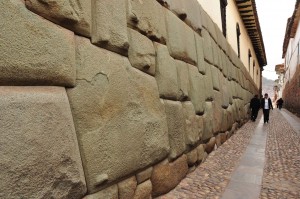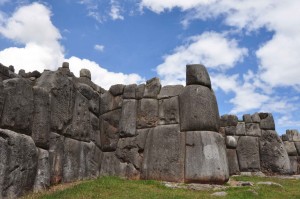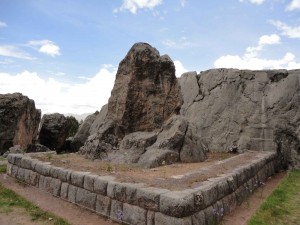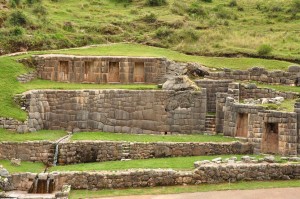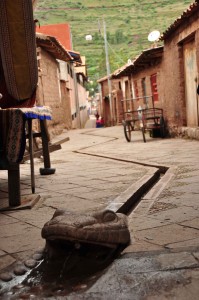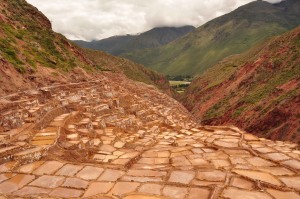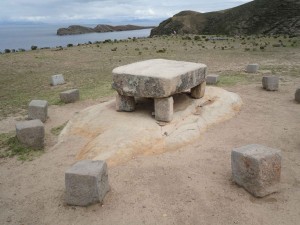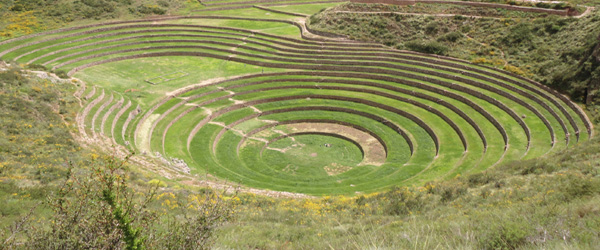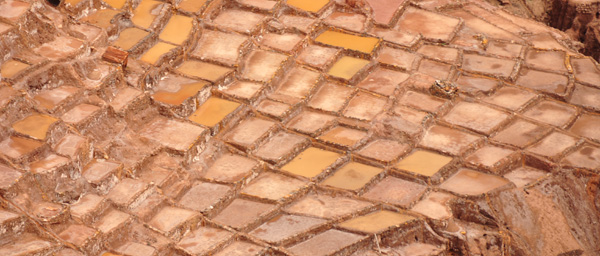I wasn’t expecting much from the Incan sites to be honest, while I wanted to do Macchu Picchu, I hadn’t really given the Incan’s too much thought before arriving in Peru, distracted as perhaps I might have been by our shamanic explorations. But when you see the phenomenal architectural achievements in their stonework and their terraces, when you feel the special energy of the sacred sites and the locations that they chose to erect their temples and learn about the Andean mythology, much like the Pyramids and the Egyptians you are quickly captivated and brought under their ancient sway.
While only in power a relatively short time before a couple of hundred Spaniards famously managed to defeat them, their architectural and spiritual legacy lives on in the Andean highlands even today. The Cusco and sacred Valley region represents the heart of the Incan empire and is covered with their ruins, but one of the most compelling things about the Sacred Valley is the active spirituality that surrounds these sites. Rituals, ceremonies and sacred traditions all continue to today and are not uncommon to encounter as you work your way around; it is also a real spiritual hub for new agers of all decsriptions and Andeans alike, one of the world’s great power spots and a fascinating legacy to explore.
As it turned out, despite a finely tuned schedule, we managed to visit many of the major Incan sights, attracted energetically to what had been put in place. I have tried to summarize some of the simple highlights below:
Cusco
The holy Incan city, the word Cusco in Quechua or Incan spiritual tradition refers to the central energy point at the centre of the body. Thus the city of Cusco, capital of the Incans was a deep power place and still retains much of this magic. The original city was designed in the shape of the Puma, long since outgrown, amazing Incan walls still line many of the backstreets set off from the square, huge rocks, perfectly shaped at all sorts of angles and joined without mortar, sitting exactly as they have for more than 500 years. Similarly, many of the foundations of the palaces, great cathedrals and churches retain the Incan foundations, built by the Spanish on the sites of the Incans greatest and most holy temples such as those dedicated to the Sun or Wiracocha. The stone foundations are also still standing today, even after earthquakes have forced the churches on top, to be rebuilt several times. It is a fantastic city to explore, compelling sites, innumerable cultural attractions, museums and souvenirs – a mega-hub for tourists, spiritual seekers alike.
Sacsayhuaman
One of the most sacred sites outside Macchu Picchu, located high on a hill looking down on the city of Cusco, it represented the head of the original cities Puma design. Designed as a fortress, the place is also the site of Cusco’s most famous festival, the festival of the Sun held on the Winter Solstice. While much of the site was scavenged for use in rebuilding Cusco by the Spaniards and only 20% remains, it is still a huge site and impressive. While only the outer walls remain the triple layers of zig-zagging, large stone walls here are particularly intimidating and once must have been a fantastic defensive network. How they managed to bring stone blocks as big as 360 tonnes up the hill, let alone cut them perfectly into place without mortar is one of ancient histories great mysteries, right up there with the pyramids.
Qenko
The site of Qenko, a large cave – rock – temple kind of fusion on a hill located just outside Cusco, has a large stone sacrificial monument as its key feature with zig-zagging channels. Incan priests would apparently poor llama blood onto the altar and the direction the blood chose to flow down the channels would determine fortunes for the coming seasons.
Also known as the element temple of fire, it contains several cave spaces and some other symbolic carvings built into the rock faces. Our biggest discovery here was a Cuy (Guinea Pig) hiding discretely among the ruins – poor guy. Once we discovered him, our attention caused all the guards and vendors to leave their posts and try to catch him – they are a special delicacy here.
Salapunco / The Temple of the Moon
This site is really off the main trail and popular amongst younger people and those doing ceremonies just to be able to hang out and spend the day in proivacy. The temple of the moon itself is a collection of caves built into a hill, featuring a sacrifical platform on top. One of the main caves has a rock in shape of a condor at the entrance, a carving of a serpent following the wall and a central doorway in the shape of the Puma. Moonlight illuminates the cave once a month, where obviously sacred ceremonies where performed. Outside there are numerous carved spaces into rocks allowing for other ceremonies and gatherings to be accommodated.
It was one of the most special places we visited I think, partly it is the relative peace and isolation of the site, but also the obviously intricate purely ceremonial design and function of the site itself, means it just radiates with a very special energy. As you would expect we met other travelers there soaking it up, play instruments and spending the day – a very welcome change.
Tambomachay
Dedicated to the element of water, this site 8km or so from Cusco, was once a ritual bath house of the royals, guarded closely by another fortress on a hill nearby. While some of the irrigation is still working, flowing through the sit much as it was supposed to, its most outstanding feature are 4, man-sized windows built into a stone wall. They are said to represent the 4 elements and that if you stand in each, you can feel the unique energy of that element (thinking feeling light like air).
Also below are 2 large masculine and feminine energy windows, said to also emanate with their own respective gender derived powers. We never got a chance to test it and charge though unfortunately. All closed off to tourists for the time being and a there were a few too many tour groups, llama towing sales ladies and other folk about to risk jumping the fence!
Pisac
Pisac is a small town, famous for its markets and as an the entry point to the Sacred Valley. Some 30 minutes from Cusco – it is also a bit of spiritual hub and full of all sorts of seekers, retreats and centres. On market days, particularly Sunday, just about every street in town fills up with classic Peruvian souvenir stands selling fake or real Llama and Alpaca wear, sacred rocks, an infinite range of jewelery and panpipes. The locals are the usually traditionally dressed, colourful, well hatted array and there are a many pearls amongst the mundane nick-nacks to be had as well.
High above the town though are an extensive set of ruins, that represent several different Incan communities, interconnected but spread across several hills, including a central temple complex, burial grounds and a series of different villages surrounded on all sides by usual distinctive terraces. It is a fun space to wander around clamouring along the trail and cliff tops, it is so big and extensive across the hills, that many tour groups only just access the easy, accessible sites leaving the place largely empty and pristine. We cheated a bit and caught a taxi to one end of the ruins and then spent several hours working our way along , through, over and under them.
Salineras
A fascinating salt farm originally designed and carved out of the side of the valley by the Incans to take advantage of a salt water spring that continues to feed the pans today. Later expanded by the Spaniards using slavery, today there are some 3,000 salt pans, each pan owned and operated by locals, having inherited it from their slave bound ancestors. The scale is impressive and although we were there in rainy season, when the pans are largely left untended, it was still a fantastic sight. In dry season it becomes a sea of white fields, each pan drained and scraped dry of salt every 4 days.
Moray
Relatively adjacent to the Salt mines, the site of Moray – 3 circular terrace formations carved into a valley is said to represent a kind of architectural laboratory for agriculture. Each of the terraces are designed to emulate certain microclimates and environments allowing the Incans to grow crops from mountain, jungle and coastal environments in a single space. As you descend through the terraces the temperatures, humidity and soil all change noticeably to accommodate and achieve this.
There are the usual other theories on the site and its uses of course, but that apart it is also still seen as a sacred site and a key location by locals for worshipping Panchamama, mother nature, the provider of bountiful harvest and good seasons. Energetically it feels like a very special place and while we were there, an Andean Paqo shaman was performing a ceremony at the base of one of the giant circles, a relatively common site in the sacred valley.
Ollyantaytambo
One of the nicest villages in the Sacred Valley and still retaining much of its original character, the small town features large Incan stone wall lined narrow streets in several directions from the small main square, creating blocks of communal housing, with irrigation water channels flowing to one side of the cobblestone streets. Surrounding the village on both sides are mountains containing spectacular ruins. On one a former Incan fortresses, complete with terraces, temples and more stunning stonework as well as a complex network of irrigation for ritual bath-houses, all designed in the shape of a llama, with a stunning mountain backdrop. While on the other mountains guardhouses, terraces and villages spot the steep faces.
Ollyantaytambo is also the launching point for the Incan trail to Macchu Picchu and also features a train station for more convenient access. Despite the many tourists that come through here though, the place resonates with a genuine authenticity that is particularly special. Staying the night in the town, we were able to work around the standard tour schedules and time both sunsets and sunrises from either side, largely having the ruins to ourselves to wander about and soak up the atmosphere. It is a magnificent location and lots of fun to explore.
Macchu Picchu
Hard to talk about Macchu Picchu, as one of the 7 modern wonders of the world everything has probably already been said and it totally lives up to expectations. Your first view and impressions as you enter the site either walking up or coming through the higher Sun Gate from the trail it is simply breath-taking. The site itself contains some fascinating architectural features – rocks shaped to mimic the design of the mountains and condors, the magnificent stonework of temple of the sun, an astronomical feature at the top of the main temple as well as a set of baths and many other features, but given all the tourists and tour groups coming through, it is really simply enough to sit back somewhere discreetly and just soak up the stunning location and views as its shifts through its daily routine of misty, sunny revelations.
We made the 1 hour climb up above the site to the holy mountain of Hyana Picchu and waited on the clouds for an hour to provide clear views of the site far below. From here you can really see the overall design of Macchu Picchu and in particular its shape in the form of a condor – the sacred bird of the upper world. From there we then made the 2 hour trek around Hyana Picchu down to the temple of the Moon, an incredibly tranquil location and sacred site built out of a cave, but resonating with a really special energy. In total we spent almost 8 hours at the sight, trekking around and enjoying its many different features and views. Truly a masterpiece and very special!
Isle del Sol
The last of the significant Incan sites we visited, this one is located on the Bolivian side of Lake Tititicaca. Isle del Sol (and the small island of Isle del Moon adjacent) are two of the most scared sites in Incan mythology. It is here that the found father & mother of the Incans were birthed through the rock of creation.
Lake Titicaca itself is a very special place. Located at about 4,000m above sea level, it is the largest high altitude lake in the world and has been populated for many thousands of years. The Lake itself is incredibly tranquil, resonating with a serene, deep silence and sobriety that is very special. The Isle del Sol, Island of the Sun is accessible by about a 2 hour boatride from Copacabana in Bolivia and it is easy to get dropped off on one end near the sacred rock and do a 3 hour trek along an old Incan trail to other end of the island where there are more ruins and lots of hostals and restaurants, all with fantastic views of the lake and surrounding mountains in the distance.
The rock itself is obviously a powerspot and resonates with a special energy, while there are few significant ruins around the site. There is a large stone ceremonial table, stools and rock circle placed directly opposite the stone emphasising its sacred nature. But it is the shapes of the islands and rocks themselves that ooze with ancient mythology, Puma & serpent shaped peninsula’s are easy to recognize, but all the hills and rocks seems to suggest distinct shapes and face around here. We could easily have spent several days on the island and would have liked to get across to the Isle del Luna as well, though were reluctant to confirm to a tour package!
![Connecting with the Sacred Incan Legacies I wasn’t expecting much from the Incan sites to be honest, while I wanted to do Macchu Picchu, I hadn’t really given the Incan’s too […]](http://meltingplots.com/wp-content/uploads/2011/04/Machu3.jpg)

